| Article ID | Journal | Published Year | Pages | File Type |
|---|---|---|---|---|
| 7884884 | Cement and Concrete Research | 2018 | 18 Pages |
Abstract
Ever since the early days of Féret (1892) and Abrams (1919), concrete research has targeted at relating concrete composition to uniaxial compressive strength. While these activities were mainly characterized by empirical fitting functions, we here take a more fundamental approach based on continuum micromechanics. The loading applied at the concrete level, is first concentrated (“downscaled”) to maximum stresses related to cement paste volumes which are directly adjacent to the aggregates, i.e. to the interfacial transition zones (ITZ). These maximum stresses are further “downscaled” to the micron-sized hydrates, in terms of higher-order stress averages. The latter enter a Drucker-Prager failure criterion with material constants derived from nanoindentation tests. The model is successfully validated across the hydrate-to-concrete scales. Strength magnitude is governed by ITZ stress concentrations, and the water-to-cement ratio is its dominant mixture design parameter.
Related Topics
Physical Sciences and Engineering
Engineering
Industrial and Manufacturing Engineering
Authors
Markus Königsberger, Michal Hlobil, Brice Delsaute, Stéphanie Staquet, Christian Hellmich, Bernhard Pichler,
